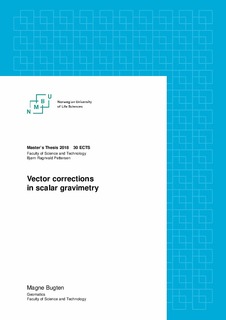| dc.contributor.advisor | Omang, Ove Christian Dahl | |
| dc.contributor.advisor | Pettersen, Bjørn Ragnvald | |
| dc.contributor.author | Bugten, Magne | |
| dc.coverage.spatial | Norway | nb_NO |
| dc.date.accessioned | 2018-10-08T12:34:36Z | |
| dc.date.available | 2018-10-08T12:34:36Z | |
| dc.date.issued | 2018 | |
| dc.identifier.uri | http://hdl.handle.net/11250/2566894 | |
| dc.description.abstract | Advances in airborne gravimetry have made increased use of global navigation satellite systems (GNSS) to successfully model unwanted accelerations, caused by the motion of the aircraft. Installation of GNSS receivers in ships carrying (traditional) sea gravimetry equipment enables the same kind of modelling for older systems. We wish to explore the use of GNSS derived accelerations in corrective models for a scalar sea gravimeter in pursuit of increased resolution and accuracy.
Unlike modern airborne (vector) gravimeters that are constructed with three perpendicular sensitive accelerometers, traditional sea gravimeters have only one sensitive axis to measure gravity with; this is why they are often referred to as `scalar'. Traditional sea gravimeters orient their sensitive axis to the vertical using a gyrostabilized platform to maximise their sensitivity to the gravitational field. Like the airborne gravimeter, the sea gravimeters are also susceptible to noise from the movement of the ship, but, high-frequency horizontal accelerations are filtered out by the gyro stabilising platform.
Gravimetric and positional data was processed and analysed using Pandas DataFrames and SciPy signal analysis tools. Custom functions for signal conditioning and interpolation were employed to estimate the inertial state at the time of gravimetric readings. We present two methods using 3D and 1D acceleration derived from GNSS to correct measurements from a scalar gravimeter.
These methods, applied on two datasets, one real-time and one post-processed, are compared to a control method. The method using real-time generated data and 3D accelerations show good results, particularly in estimating and compensating for horizontal accelerations form situations outside the practical limitations of the stabilising platform. However, we have not obtained the crossover RMS performance of these methods. | nb_NO |
| dc.language.iso | eng | nb_NO |
| dc.publisher | Norwegian University of Life Sciences, Ås | nb_NO |
| dc.rights | Navngivelse 4.0 Internasjonal | * |
| dc.rights.uri | http://creativecommons.org/licenses/by/4.0/deed.no | * |
| dc.subject | Sea gravimetry | nb_NO |
| dc.title | Vector corrections in scalar gravimetry | nb_NO |
| dc.type | Master thesis | nb_NO |
| dc.subject.nsi | VDP::Mathematics and natural science: 400::Geosciences: 450::Other geosciences: 469 | nb_NO |
| dc.description.localcode | M-GEOM | nb_NO |

